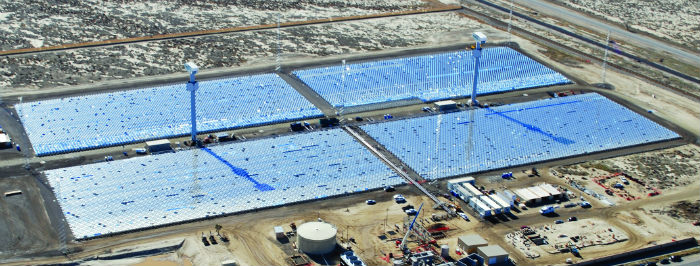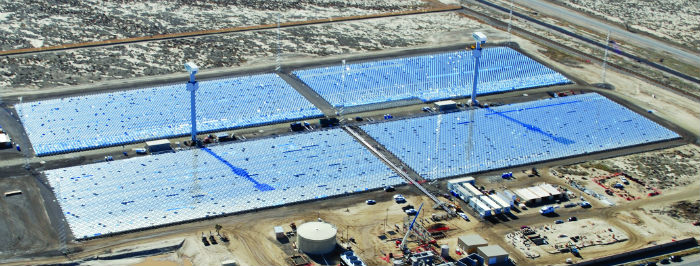
An overhead view of eSolar’s Sierra solar array, located in Southern California (Photo courtesy e-Solar)
I’m sitting in the back of a black Lincoln Continental with eSolar CEO Bill Gross on the downward glide into Antelope Valley, a sun-blasted stretch of semi-suburbanized desert northeast of Los Angeles. We’re on our way to take a look at an alternative future called Sierra, the Google-backed startup’s first solar power plant and the prototype for what might be called Solar 2.0 — green energy that’s as much a product of software and computing firepower as steel and glass.
California has become an epicenter of green tech innovation, and I’ve written endlessly about the stream of Big Solar deals utilities have signed to carpet the Golden State with solar farms. Most, however, exist only as futuristic artist renderings (and some undoubtedly will remain frozen in PowerPoint). But steel is starting to go to ground and a shakeout is inevitable — the winners will be those solar technologies that produce the most carbon-free electricity at the cheapest prices.
“Two years ago when we were developing this design we looked at all the resources that go into making a solar plant and the cost of virtually all those commodities — steel, copper, aluminum — was going up,” says Gross, a laptop balanced on his knees. “The only thing going down was the cost of processing power. So we consciously decided to trade a design that needed much more computational power in return for using less materials.”
In an industry populated by engineers and scientists, Gross is a software guy with some serious smarts. Some of the dot-com era companies hatched by his Idealab tech incubator might ring a bell – eToys, CitySearch, GoTo.com. That last one pioneered search advertising, an idea later embraced by a little startup called Google. Yahoo subsequently bought GoTo for $1.6 billion. Gross walked away from the crash of ’01 with a lot of cash to play with, and he went on to start a series of alt-energy companies. (The roof of Idealab’s Pasadena headquarters is a Mr. Wizard’s workshop of solar, with prototypes of various photovoltaic technologies silently working away under the sun.)
Gross’ solar dreams began as a teenager during the 1973 oil crisis. “I started making little parabolic dishes out of cardboard and tinfoil and then started making them out of metal in metal shop,” he says. The 15-year-old started his first company, Solar Devices, and began selling plans for solar dishes in the back of Popular Science magazine for $4 a pop. Ten thousand sales later he had his tuition to Cal Tech in the bank.
Like his rivals at other solar startups, Gross is determined that the current solar boom won’t be a repeat of that ’70s show — when solar farms blossomed in the Mojave Desert but their builders went bankrupt when oil prices dropped and interest in (and tax breaks for) alternative energy became as fashionable as Farah Fawcett.
“The only way you’re going to make a big enough impact is if you can compete with fossil fuels with no subsidies, and the only way to do that is at a very large scale,” Gross says as the foreclosed subdivisions of the blue-collar exurb of Palmdale give way to open desert pockmarked by abandoned trailer homes and burnt-out pickups.
Two thin white towers appear on the horizon and we pull off the highway, heading to the construction site of the five-megawatt Sierra demonstration plant. The towers, framed by the snow-capped San Gabriel Mountains, appear to be surrounded by a shimmering lake, an effect created by 24,000 mirrors turned toward the sun. A standard 46-megawatt eSolar farm will have 176,000(!) mirrors.
There’s nothing particularly new about “power tower” solar thermal plants. Arrays of mirrors called heliostats track the sun and focus its rays onto a water-filled boiler that sits atop a tower. The intense heat vaporizes the water and the resulting high-pressure steam drives an electricity-generating turbine like those found in conventional power plants.
eSolar’s innovation is to rely on software and imaging technology rather than complex hardware to concentrate the sun’s energy. The difference becomes apparent as Gross and I don hard hats and walk along the perimeter of the plant, which is swarming with workers installing a giant turbine in the unfinished power block. In other power tower designs, each heliostat is picture window-sized or larger and slightly curved to create a parabola to focus the sun’s rays. That means each mirror must be precisely placed, spaced and calibrated in the field.
These eSolar mirrors, in contrast, are flat and about the size of an LCD television screen, packed tightly together in long rows. They sit seven to a platform that rolls off an assembly line in China with the motors and circuitry built-in. The makes it possible for just two workers to install the “sticks” on concrete ballasts and attach the mirrors. Since the heliostats are small and flat, far less steel is needed to hold them in place.
“The new thing is distributing 176,000 mirrors around a field and pointing them to one spot without requiring a human to calibrate every one of them,” says Gross, who happily bops around Sierra like a boy in a very big toy store – at 50 he still seems like the Doogie Howser of solar. “That’s our key breakthrough.”
It’s all about the algorithm. Flat mirrors won’t focus the sun, so eSolar’s software creates a “dynamic parabola” out of the entire heliostat field to concentrate the sunlight on the power tower. He points to one of the 100-foot cell phone towers that ring the site. Each tower sports several 10 megapixel sensors that constantly scan the solar field, pinpointing the location of each mirror and the sun’s reflection. With the precise position of the sunbeam on each mirror known, eSolar’s software sends messages to the microprocessor in each seven-mirror stick so that the arrays align themselves to form a long sweeping curve across the solar field. That saves the company from doing extensive and expensive surveys to lay out the solar field; if the rows are crooked the software corrects for it.
Not too ago, it would have cost $1,000 for each of the 25,000 microprocessors used in the solar field; today the price is 50 cents. “We use Moore’s law rather than more steel,” Gross likes to quip, referring to Intel co-founder Gordon Moore’s maxim that computing power doubles every two years.
In the middle of Sierra’s four solar fields stand two off-the-shelf windmill towers. On the ground sit two massive receivers that look like supersized Winnebagos. When the receivers are hoisted atop the towers, the heliostats concentrate an intense beam of sunlight through openings at each end to super heat water-filled pipes. “The benefit is that even if some light is reflected it can have multiple bounces and still hit the pipes,” Gross says. “We can get all the light inside the cavity all because of the software that controls the mirrors.”
The bottom line: Gross claims eSolar will produce greenhouse gas-free electricity cheaper than what can be produced by natural gas power plants. By packing so many mirrors close together, an eSolar plant needs less land than competitors and can be built closer to cities and transmission lines. The company, which has spent $30 million buying land in California and New Mexico, last year signed a 245-megawatt deal with Southern California Edison and in the past month has licensed its technology to coal-fired New Jersey utility NRG as well as to an Indian conglomerate that plans to build 1 gigawatt of solar farms over the next decade.
And like other solar power plant developers, eSolar stands to benefit from the recently enacted federal stimulus package that allows renewable energy companies to receive a 30 percent tax credit in cash and apply for guaranteed government loans. Gross says a new 30 percent tax manufacturing tax credit for renewable energy components makes building a heliostat factory in the United States all the more feasible.
Sierra is set to go online in the next couple months. And while it’s fun having a hard hat with your name on it, Gross’ real aim is to become a solar software and technology supplier, not a power plant builder. “I think eSolar can be the Intel inside of the solar industry.”


